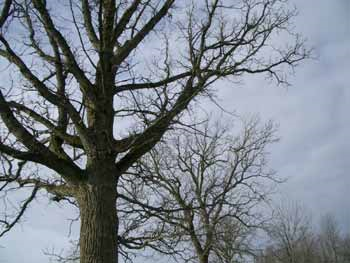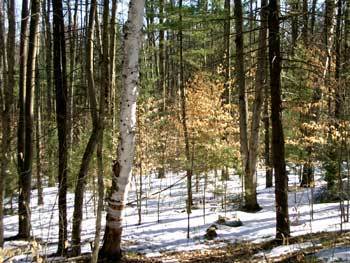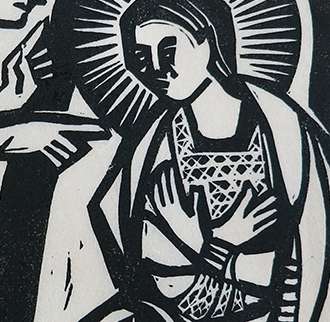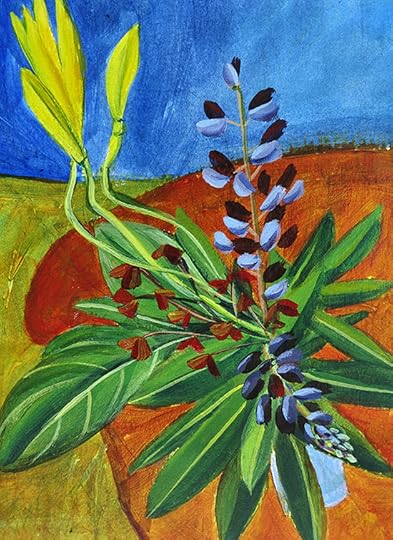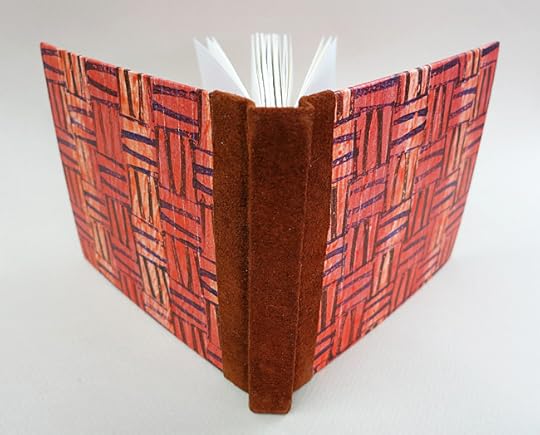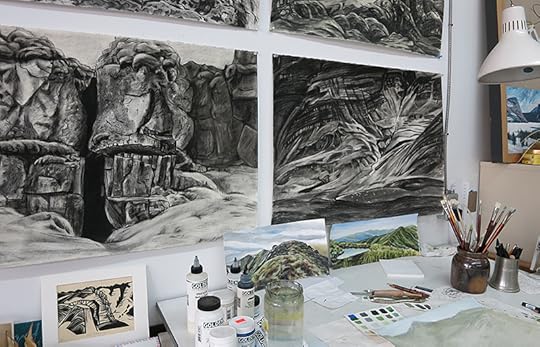Elizabeth Adams's Blog, page 51
March 17, 2015
Journal entry, 2004: Anticipating a Transition
In my Vermont house, 2004
Last Wednesday I sat down to write something in my journal, and noticed that it was the 500th page of the file that I had begun in April 2004. Coincidentally, the journal begins with a quote from Merton: on Tuesday night my short talk to the meditation group had been about Merton, too, so he was on my mind.
Here's that journal entry from 2004; later I'll post what I wrote there the other day.
April 26, 2004
In winter the stripped landscape of Nelson County looks terribly poor. We are the ones who are supposed to be poor; well, I am thinking of the people in a s hanty next to the Brandeis plant, on Brook Street, Louisville. We had to wait there while Reverend Father was getting some tractor parts. The woman who lived in this place was standing out in front of it, shivering in some kind of rag, while a suspicious-looking anonymous truck unloaded some bootleg coal in her yard. I wondered if she had been warm yet this winter. And I thought of Gethsemani where we are all steamed up and get our meals, such as they are, when meal time comes around, and where I live locked up in that room with incunabula and manuscripts that you wouldn’t find in the home of a millionaire! Can’t I ever escape from being something comfortable and prosperous and smug? The world is terrible, people are starving to death and freezing and going to hell with despair and here I sit with a silver spoon in my mouth and write books and everybody sends me fan-mail telling me how wonderful I am for giving up so much. I’d like to ask them, what have I given up, anyway, except headaches and responsibilities?
Next time I am sulking because the chant is not so good in the choir I had better remember the people who live up the road. The funny thing is, though, they could all be monks if they wanted to. But they don’t. I suppose, somehow, even to them, the Trappist life looks hard!
--Thomas Merton, The Sign of Jonas, pg 149. An entry from January 8, 1949.
Late winter woods, Vermont, 2004
It’s a grey, dark day here, and when we woke there was rain pelting against the roof. The storm has let up now, and in the bathroom the rainwater is slowing sliding down the incline of the skylight, blurring the silhouettes of the bare-branched treetops. This is the sort of weather that has been depressing me all through the late winter, but today it seems almost indescribably beautiful. It is practically the last day for bare trees; leaf buds are swelling on all the red maples and the honeysuckles are already covered with a cloud of pale green. On the apple tree outside the bedroom window, drops of water hang from the ends of each black twig, daring both gravity and time.
In less than a week, we’re heading to Montreal to live for a month. This will be the longest amount of time I’ve spent in a city in my half-century of life. We’re going as a change from the life we’ve led here, from the house we’ve inhabited for more than 25 years, from the rural countryside, from the particular web of responsibilities and patterns we’ve woven. Besides being urban, Montreal is an international city: proudly and gracefully maintaining its French heritage and a broad ethnic and cultural diversity despite its proximity to the United States and the English-speaking provinces of Canada. It is a mere three-and a half-hours from here, and a world apart.
We’ve been thinking of this month as an experiment. After several years of weekend trips and the occasional week-long stay we want to find out what our commitment to this city really is: how much do we really like living there, and what might that mean for our future? This is what I thought the month was going to be about: practical matters, finding out how we felt, considering some changes and potential investments at this gently teetering point of midlife. Strange, then, that on this wet dark morning I felt, for the first time in several years, a strong call to contemplation. Could it be that part of this journey might be a sort of retreat, bizarre though it seems to retreat to a city? And yet I feel the call so clearly, bidding me to use the coming time and change of place not for distraction and escape, or merely for outward life decisions, but to learn something inner and as yet unrevealed.
For those who believe in God and believe, further, that She has a sense of humor, consider the irony of moving a writer - especially one steeped in the ultimate contemplativeness of rural Vermont life, complete with clapboard-clad house and vegetable garden, and a pervasive silence punctuated only by bird and cricket - to the bustle and endless distraction of a city of three million souls for the purpose of contemplation. Funny, even preposterous. But that’s what may be happening. I’ve been on this winding, unpredictable, and largely dusty spiritual path for long enough now to recognize the changes and imperatives when they come - and for the most part, they have come like this, of the blue.
What immediately fits is the fact that contemplative solitude, for me, is actually easier to find in the city. Having lived my entire life in the fishbowls of small towns, where I cannot step outside my door or buy a bag of carrots without running into someone who knows me, the anonymity of the city is a huge relief. It creates a sense of freedom that is impossible for me here. Perhaps because of living so many years in the country, close to nature, solitude -- for me -- is not dependent on silence, but on being removed from the obligation to talk, interact, and plan. And yet, being a social creature and a moderate extrovert, and knowing that my husband – the opposite - likes to take off for long periods of photographic exploration on his own, I’ve been a little worried about having to deal with too much solitude during an entire month of urban living. “Use it,” I hear now. “It’s a gift.”
This morning there’s much that I don’t understand. Is this simply an emotional reaction to the Merton I’ve been reading – the kind of excited, creative impulse I often feel when reading or seeing something that inspires me, but which afterwards reveals itself as just that – a kind of steamed-up excitement that quickly evaporates when I steps out into the daily reality of life? Or is it the real thing, which, if I follow it out, will lead me somewhere I’m meant to go? And in that case, what was that decision to pick up Merton during Holy Week? How do we ever know these things? All I know is that certain books have leapt off shelves into my hands for years, and changed me, and changed the course of my life and my thinking. What I suspect is that in this case, choosing to read this particular volume of Merton again was a sign that I was entering into a psychological place that was receptive to contemplation. What I didn’t do was connect it to the upcoming travel. And whether that happens or not depends on my assent to the invitation.
March 15, 2015
The different shapes of progress
There are different forms of progress, or so it seems to me.
Incremental progress is like this quilt: you follow a progression based on certain necessary steps, you keep at it, a little bit every day, or every week, over a long time, and eventually you arrive at your goal. It's like a long walk from here to there, or the slow action of water on rocks. Sometimes it's arduous and more uphill, with twists and turns; sometimes easier and more linear, but you usually get somewhere close to where you thought you were headed if you are dedicated and steady. Maybe the goal is a project, or a degree, or some sort of change you want to achieve, like getting in better shape or becoming a kinder person. Whatever it is, you aren't going to get there overnight, but by a long series of small steps.
Then there's another kind of progress that's more like an earthquake; the whole mountain shifts, a faultline opens, the view changes, and suddenly you realize you aren't where you were before, or maybe that the you who is here now isn't the you that was there, then.
This second kind of movement may not feel like progress as much as upheaval, transition, turmoil, major change or even disaster, but when the dust settles - which can take years or even decades - you finally see more clearly what's happened. Life, whether we wanted it to or not, has pushed us into a new place.
My life has held hundreds of the first kind of processes: incremental projects that have resulted in something fairly concrete or tangible, or have taught me something important or changed me, even if the goals shifted a bit during the process or I encountered surprises or difficulties along the way. For the most part I've sought them out deliberately; I've put myself on those paths, or agreed to them more or less consciously, and then tried to see them out to a conclusion, or as lifelong commitments. It's one thing to make a quilt, another to take up the piano again as an adult, another to embark on a marriage or parenthood -- but they all involve decisions, persistence, and faith that the process itself is worthwhile, even if we encounter great difficulties, even if the end result isn't always what we hoped for or looks an awful lot like failure. Actually, with some practice at these projects, and at learning from them, you come to accept the failures as part of the path itself -- as teachers in their own right -- and you stop disliking them (or yourself) so much.
But the other kind of movement is very different. These major shifts have happened to me every decade or so: life takes a certain direction, both because of choices and external conditions or events, and then follows a kind of arc as that particular combination of choices and circumstances plays itself out. Then something changes, and a new, different reality announces itself, sometime suddenly, but more often quietly at first, and then with more and more insistence. At the same time, I sense that something else is ending or coming to a conclusion. Sometimes I don't notice the signals as positive promptings, but instead I notice resistance. That resistance can be to something old that I don't seem to want to do anymore, or it can be resistance to something new that feels unwanted, or represents loss or too much change. Pretty soon, it becomes clear that I'm at a crossroads, like it or not, and I'm going to have to look at it squarely in the face and do the work that the major change represents and calls for.
It's a lot easier to see these things in hindsight.
Loosely speaking, my twenties were about figuring out what I wanted to do in life, and ended with moving to New England, starting my design business, meeting and falling in love with J., getting married, and then combining our businesses into a partnership.
My thirties were about building that marriage, our home, and our professional career, and ended with a personal crisis about my own creative and spiritual life: in other words, I felt the need to step back a little bit from the intense coupledom with which I'd been consumed, and reconnect with my individual self -- to figure out some more about who I was, and pick up some important threads that I'd dropped.
My forties, then, were about becoming a serious writer and working on that very hard; studying piano and voice again; exploring my spirituality; and beginning to confront my deepest fears about mortality and loss - and trying to balance all of that with my marriage, our busy professional career, family relationships, friendships, community work and social activism.
In the next decade we faced the decline and death of three of our four parents, and moved to a new country, giving up our home, rural life, and many of our possessions. My fifties were about actual illness, loss, death, personal change and upheaval -- but they were also about writing a book, the internet, blogging, and a whole new realm of possibilities for sharing one's creative life.
That period of time has resulted in a new home, new friends, a large body of work, a new publishing business, and new responsibilities and challenges (the choir, the contemplative group I facilitate, bilingualism, travel to different places.) These years have felt chaotic and difficult but also richly rewarding, and probably represent the greatest period of change and growth in my life. It's only in the last two years that I've felt like I was actually settling in up here, feeling pretty comfortable and relatively adjusted to urban life in a foreign place - which Quebec really is - where I will never fully "belong" and have to find that sense of home within myself, instead.
And now I feel the ground shifting yet again, two years into my sixties...
(to be continued)
March 11, 2015
Melting, Slowly
March 7, 2015
Process
It's not like I don't have plenty of work to do. So why was it that yesterday I gave into the increasingly insistent urges and began a new quilt?
It's Lent. It's still mid-winter, and freezing cold, and monochromatic up here. Those are reasons for craving color, for sure, but there are lots of ways to get more color in your life - like wearing hot pink, which I'm doing today too; yesterday was orange. But no, it's more than that. It occurred to me last night that this is a kind of longing-for-spring quilt: green for leaves, roses and reds for flowers, brown for earth. When I was pulling out the fabrics, all that was subliminal.
I feel better when I have something like this to work on, a little bit at a time. It's amazing to me how much I look forward to it each day. Sewing, or bookbinding, or the actual process of cutting relief blocks or making prints all do this for me, while knitting, on the other hand, tends to be too repetitive for me; I like the planning but not the doing, so much -- but that's just me. Painting can be quite difficult, demanding, and often fraught, like serious writing. Maybe I just like the process of making practical things - real objects - without a client or deadline or the prospect of submission looming in the background. Maybe it's an escape from, or antidote to, other kinds of work which generally involve commitments to others or to something more demanding within myself. Whatever it is, work that involves a lot of "process" seems to be therapeutic, calming, spiritually and emotionally helpful. I realize that I've turned away from this too often in recent years, as a way to rest and recharge.
This has also been the first week of an experiment: I've gone off Facebook for at least the rest of Lent, not so much as "fast" or giving up of something pleasurable -- I wanted to see if I felt more focused without it. After one week, I can say that the answer is definitively yes. I check FB once a day, in the late evening, and don't spend more than five minutes doing a quick look at any messages and notifications. Unless something really needs a response -- a friend's father died a few days ago, for instance, and I didn't see that until today -- I'm trying not to comment or "like" very much at all, and I'm not posting anything but links to new posts here. We'll see how it feels after several weeks, but so far, I don't miss it. I like the way my mind feels without the chattering input, and there are some other aspects of self-perception that are beginning to be more apparent. More on that as I, ahem, piece it together.
March 3, 2015
A Dream
Last night I had a dream in which I was meeting someone who seemed to be interviewing me as part of a college application process; it seemed that I was trying to get a degree in English. In the dream, I knew that I had already completed most of my studies - maybe three out of the four years - but now, with some anxiety, was trying to go back and finish, many years later. (The whole notion of time was rather shaky in this scenario.) Anyway, the interviewer, who was an Indian man, was showing me the pages of a large book of maps, and as we turned them I asked questions about India, and different kinds of food appeared on the pages -- real food. One of these was an oily, delicious, puffy bread with a spicy meat, onion, and tomato topping, and we broke off pieces and ate them.
Then he asked me what the titles were of my most favorite books, and try as I might in the dream, I couldn't remember a single one.
February 26, 2015
Still winter...but there's hope
This picture is for my friend Leslee in Boston, who writes, "The snow here is all bunched up (and dirty) between buildings, as I imagine it is in Montreal." Yes, you're quite right, Leslee. Today is still frigid - minus 14C - but I did go out to Little Italy and the Jean-Talon market yesterday to do some shopping, and managed to take my gloves off long enough to take this photograph. It was OK in the sun, but the wind was straight from the arctic and very strong, blowing my furry hood off my head whenever I turned to face it and sending clouds of dry light snow whirling off the roofs of buildings.
Some of us are still pouting, curled up in wool and fleece...
But others, like me, are starting to feel the pull of outdoors and the increasing intensity and healing power of the sunlight. The lack of light up here is really no joke. Canadian are all urged to take Vitamin D because we tend to be deficient simply by virtue of our latitude, and a lot of people suffer from SAD (seasonal affective disorder) and are helped by special lamps. Nearly everybody is affected one way or the other by the sheer length of the winters, let alone the extreme cold like we've had this year. I just begin to go stir-crazy with what we always called cabin fever in New England, and no matter what, I have to get outside and moving. I miss downhill skiing, and wish my knees had held up so that I could have continued!
But in the studio, our plants are clearly telegraphing the message of lengthening days:
That's not just a forest of avocado plants, but a batch of cherry tomatoes that came up from seed that must have been hiding in the planter, a gift from my gardening friend Eric F. back in October, and are now spilling over. I've thinned them and am pinching them back. On the left, the four-year-old lantana is bushy and vigorous after I cut it way back around Christmas. On the right is a geranium I rescued from a neighboring studio after they moved, along with this massive cactus:
And the bougainvillea is still pumping out its gorgeous blooms, delighting me up every morning when I walk into the studio...
...and reminding me that in exactly one month, I'll be here:
And when we return two weeks later, it really will be almost-spring.
How are you holding up, if you're in the north? And if you're in a warmer climate, what are your first signs of spring?
February 24, 2015
The Cold, Cold North
Abandoned farm near Lake Champlain.
Fort Montgomery, on the western side of Lake Champlain near Rouse's Point, built at one of the northernmost strategic points of the American part of the lake, to protect against an attack from British Canada (1840s-1870s.)
Snow drifts, eastern side of Lake Champlain near Rouse's Point.
February 22, 2015
Around the World Blog Hop
Laura Frankstone, whose beautiful drawings and paintings I've admired for a long time, has invited me to participate in an around-the-world blog hop of creative artists. The rules are simple: answer the four questions, and then nominate another artist to follow you. So here goes!
1) What am I working on?
Right now I'm working on two book projects. One is a poetry book that my press, Phoenicia Publishing, will publish in March - it's a "dictionary" of poetic aphorisms and epigrams by Magda Kapa, a Greek writer now living in Germany. Each entry, containing a noun and a definition, or a poetic "comment" - is no longer than 140 characters, and they were originally published as tweets over the course of a year. I felt that the design needed to be different from a regular book to best reflect its content. Magda said that she thinks of the project as a Heraclitian river - a river that is always changing; one can never step into this same river twice. So in my design I've tried to do the same thing. (The cover is described at the end of the previous post on this blog.)
The second project is a much more complex one: a book that will come out at the end of 2015. It will be an anthology of poems about Mary and the Annunciation, and I've invited fifteen women poets from widely varying cultural and religious backgrounds to contribute work. I'll be illustrating the book with original relief prints like the one at left, editing and designing the text, and maybe printing and binding a special edition - we'll see! I'm very excited about this project because it is going to push me as an illustrator, printmaker, and book-artist, and force me to learn some new skills, and at the same time I love the collaboration with the poets, some of whom are longtime friends and acquaintances, and some who I'm just getting to know.
Last year I kept a sketchbook and tried to draw almost every day - so I'm hoping to keep that practice up this year too. And I work on personal paintings or prints whenever the urge strikes.
Lupine - a drawing from my sketchbook.
Daylily and Lupine, acrylic on paper.
2) How does my work differ from others of my genre?
It's never been useful for me to think about my work in comparison to others, except so far as I am inspired, challenged, and encouraged by the work they do. I don't know how my work is different - it is simply my work, and I try very hard to be true to my own path, to listen to my intuition as well as my intellect, and to see each project as a stepping stone to the next. I will say that, as someone who started out doing traditional realistic work, it's been a challenge to find my own style(s) and express myself in a way that is uniquely mine. The process of searching and going deeper always continues, and it's very personal.
Handbound book with suede spine and handpainted/handprinted cover papers, 2013.
3) Why do I create what I do?
Again, that's hard to answer! When I look back over my life - I'm 62 now - I can see the threads running through it, but it's much harder to speak about the present, let alone the future. I'm someone who plans, but I also trust intuition and "the muse," and the way one thing often leads to another if you work hard, think hard, then let go and open yourself up, and really give yourself to it. I have a liberal arts education and am almost completely self-taught in art and design. My career has been in graphic design; I've loved the book arts since I was a child, but I'm also a painter who works in many mediums and who loves drawing. I'm doing less commercial design work than I used to, but now I have this publishing venture that is leading me ever further into collaborations with other artists, photographers, and writers. I want to push "the book" farther, using both technology and traditional methods and materials, but I also want to use the time and freedom I have now to do the best art and writing that I can. Having said that, at the base of everything, I'm always inspired by nature and the beauty and mystery of human beings.
The studio with some large charcoal drawings of Iceland, a print of Montmorency Falls in Quebec, and two smaller paintings for a friend in New Zealand.
4) How does my creating process work?
If we're talking about a complex project, usually an idea presents itself - often as an outgrowth of something else - and I think about it for a few days, to allow the initial excitement to settle down and some questions about feasibility to surface. I listen hard to my intuition, and if it tells me to proceed, then I go for it wholeheartedly. If there are doubts, I either wait or move on. The actual process depends on the end product: if I'm making a print, I always begin with a series of drawings, but my large drawings are usually done at one go. Designing a book is a complex, picky, and often technical process that takes place mostly on the computer; it may include hand artwork, photography, calligraphy or drawn type, image processing, scanning, and several different software programs.
Two persimmons.
But in terms of spontaneous work, if I'm inspired by something I see or feel, I try to capture that quickly by sketching or painting something expressively. I've found that the practice of drawing a little, everyday, makes it much easier to work on bigger things when inspiration strikes. When I was sixteen, I took a summer art course where we had to paint for three hours every single morning - that was very good for me, and showed me that you can work in spite of difficulties, lethargy, different moods and physical states. I've always been pretty disciplined, and I'm grateful that since moving to Montreal I've had - for the first time in my life - a large studio with excellent light in which to work. The rest is up to me, and the first step is to show up every single day.
--
Thank you, Laura, for inviting me to participate here! And now I'm going to pass the baton across the Atlantic, to my dear friend and artist extraordinaire, Natalie d'Arbeloff, in London.
February 20, 2015
Calligraphic Art Revisited
Going through an old photo album today, I came across this picture of myself with "His Nibs" Philip Poole in London back in 1997. Poole was an expert on calligraphic pens, nibs, tools and supplies of all kinds, and he both sold and collected them. He had a small shop at the back of Cornelissen, the famous art supply store on Great Russell Street, not far from the British Museum. When I met Mr. Poole in the 1990s, he was already quite old and rather infirm, but he came into the shop every day, and seemed happy to talk to calligraphers like myself. Somewhere, I've got a printed broadside he gave me showing an array of antique pen nibs from his collection, and of course I bought some nibs as well. He was a fixture of the British calligraphic community and I'm glad I got to meet him in person. It looks like some of his collection is now in the Philip Poole Room of the Birmingham Pen Museum.
At the beginning of my graphic design career in the mid- to late 1970s, I made a good part of my living doing calligraphy - from wedding invitations to larger jobs like lettering the matriculation certificates for the entire Dartmouth freshman class. But by the 1990s, my husband and I were doing advertising and corporate graphic design, while my interest in calligraphy had become more artistic.
Oddly enough, while looking through my flat file today for some work to include in an exhibition at the cathedral during Montreal's Nuit Blanche next week, I came across the piece shown above. The theme of this year's Nuit Blanche is "Light," and what could be more appropriate? This mixed-media work incorporates texts from the first chapter of the Gospel of John about incarnation and light and darkness, such as "In the beginning was the Word, and the Word was with God," "And the light shineth in darkness and the darkness comprehended it not." It's a big panel, about 22 inches wide, and unfortunately I wasn't able to photograph it very successfully. Here's a detail:
The texture is built up from many layers of ink, gouache, intense black sumi ink and acrylic, with brushwork and overlapping layers of calligraphy, removal and scratching-through. This kind of expressive calligraphic treatment of a text was spearheaded by an American calligrapher named Thomas Ingmire in the late 1980s and taken up by many talented calligraphers who had previously felt constricted by the page and the need to make "perfect" letterforms. I found it all enormously exciting and liberating, and did some experimental pieces that also incorporated repetitive printed elements, though my artwork eventually went in other directions.
My studio wall in Vermont, twenty years ago.
However, I came back to it just last week when I was working on the cover for a forthcoming Phoenicia book by Magda Kapa, titled All the Words. These techniques seemed perfected suited for her book, and although I can't show you the cover just yet, it felt exciting and natural to work with letterforms, painting, and printing in that way again. Finding these photos and older works today just seemed poetic, and a serendipitous affirmation of the way things come around again.
February 17, 2015
Fat Tuesday
Fromagerie Fritz Kaiser, Noyan, QC
Since it's Mardi Gras, Fat Tuesday, Shrove Tuesday...i.e., the day before Lent begins and traditionally the last chance to stuff ourselves with fat and sugar, here are some photos from Fromagerie Fritz Kaiser in Noyan, Quebec, where we stopped today after doing some errands.
This fromagerie has won many awards, and we agree: they make some of the best cheeses (from both cow and goat's milk) we've ever tasted. It's just north of the US-Canadian border, and we used to stop there often when visiting our family on Isle la Motte, the northernmost of the Lake Champlain islands. Recently, the fromagerie has built a new store on the front of the facility where the cheese is made. The barns and the cows are right beside it. The prices for the cheeses are much less there than in Montreal stores, and you can taste anything you want to try.
In the foreground, above, rounds of goat brie and chevrechon, a soft surface-ripened goat's milk cheese.
This is Le Douanier, which won the Canadian Grand Prix in 2004. I can't even begin to tell you how delicious it is. It's somewhat similar to Morbier; this is what Fritz Kaiser says about it:
A semi-soft cheese with a washed and brushed rind, Douanier is left to ripen for more than nine weeks. The edible vegetable ash layer that runs through the centre of the wheel symbolizes the Quebec-US border close to where the cheese is made. With its earthy aroma and organic flavour, Douanier tempts the palate with a hint of nuts and green apple.
OK. Now we're going off to the cathedral's annual Shrove Tuesday pancake-and-sausage supper. And tomorrow evening I'll be singing the Allegri Miserere, and the ashes will be on my forehead, not in my cheese.


